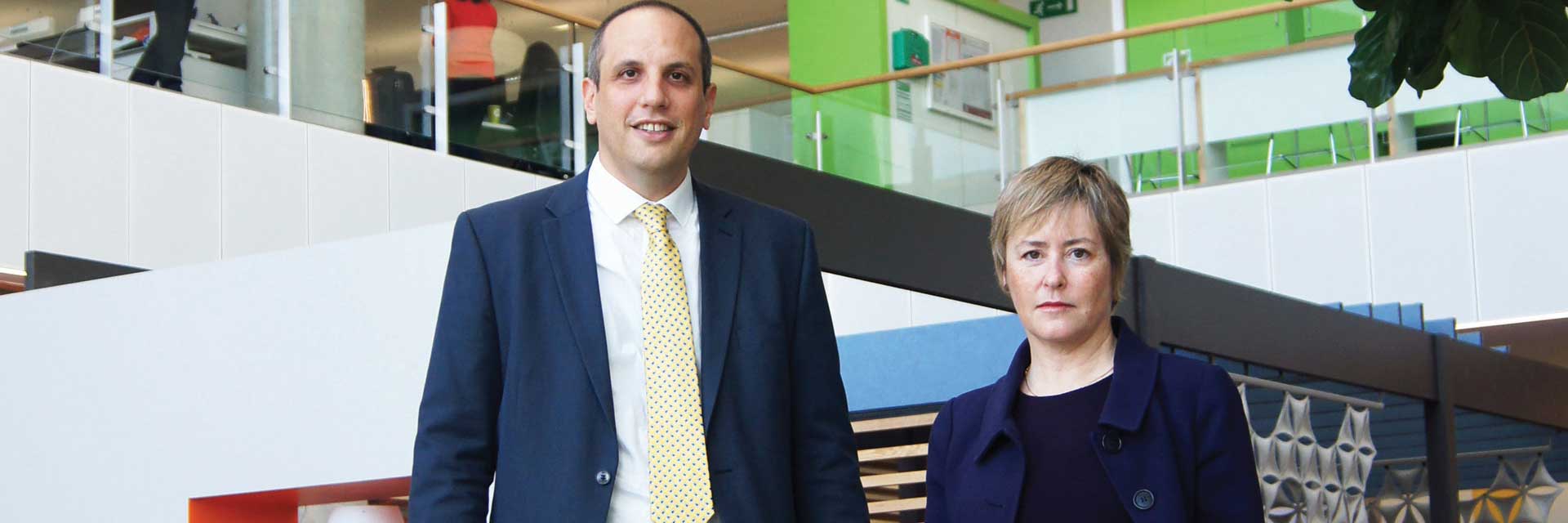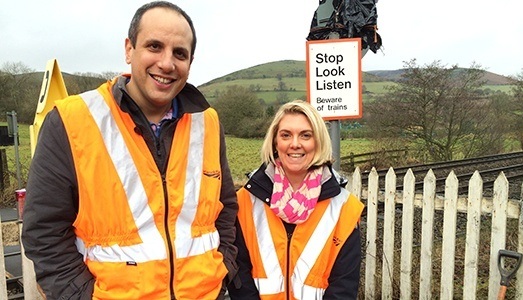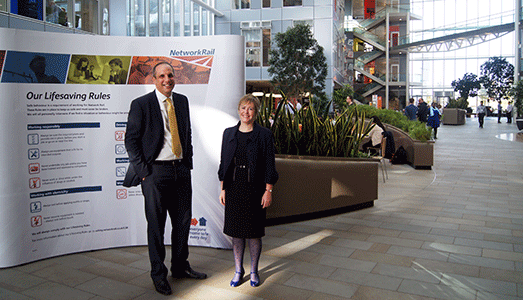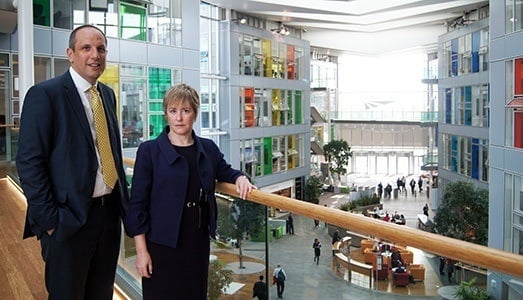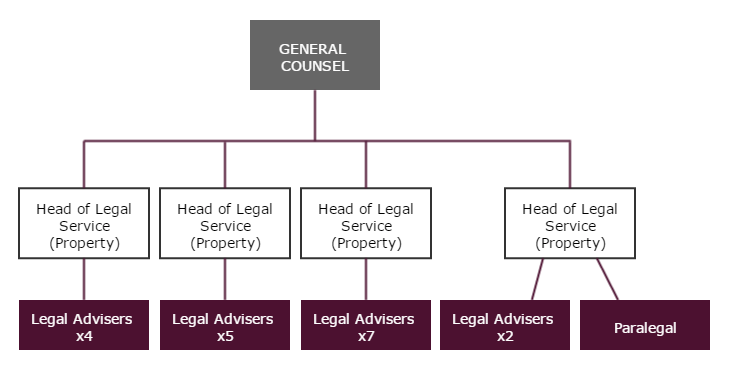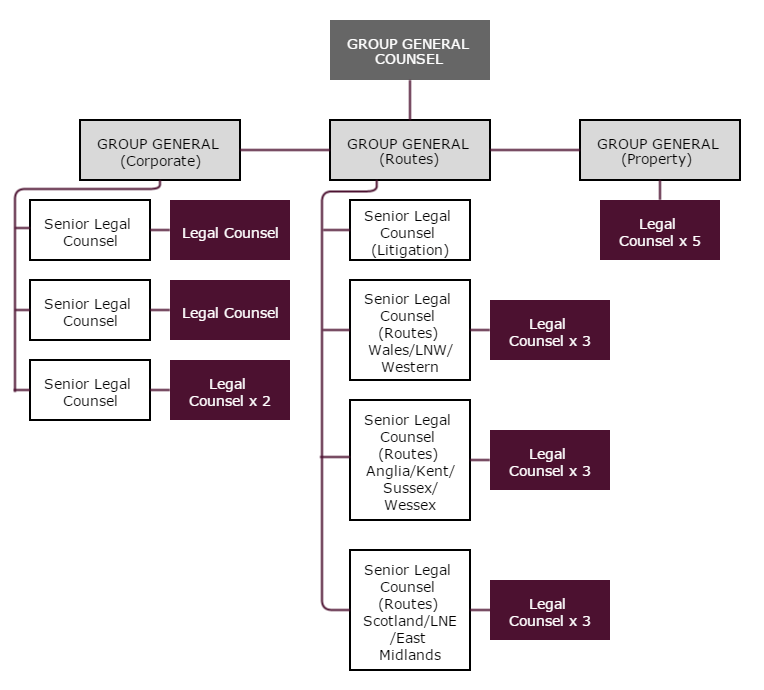In the first of a series profiling legal departments that are pioneering innovative Ways to meld legal with business, GC meets with UK rail infrastructure company Network Rail’s Natalie Jobling, Cathy Crick and Dan Kayne.
An objective eye is obviously vital for lawyers, but it is also expected that GCs will deliver a legal function that is aligned with business needs. So how can you go about transforming your relationship with business partners so that you see them less as ‘clients’, and more as ‘colleagues?’
Picture the scene. It’s 11 o’clock on a moonless November night. Snow is beginning to crust your orange boilersuit as you step gingerly along the railway line. The members of the engineering team accompanying you are unfazed by the trains which speed nearby (perhaps they have evolved night vision), but this is your first time on the track, and you are hyper-aware. This isn’t what I expected when I left law school, you think.
It isn’t what in-house lawyers typically bargain for, but for the 28 members of Network Rail’s legal team such expeditions have become part of the job. Of course, the issues faced by an organisation such as Network Rail are not typical – the owner and operator of Britain’s rail infrastructure exists in a highly regulated sector. This means balancing compliance with statutes that often date back to the 19th century with a need to be commercial in the 21st century. Not so easy when your customer base has increased by 50% in just ten years (that’s four million people using the network every single day) and you’re one of the country’s largest landowners. To better meet these challenges – and the company’s own commitments such as investing £38 billion in improving the railway and closing 500 level crossings over five years – Network Rail restructured. In the eighteen months since, the legal team, led by group general cousel and company secretary Suzanne Wise, has overhauled its own function, to mirror the new-look organisation and to ensure the support it offers reflects what business colleagues really want and need.
Reconnaisssance
In a critical first step, legal conducted a survey to match its perceived delivery against the areas that were most important to business departments. The results were interesting, according to Natalie Jobling, general counsel for the corporate legal team. ‘The areas where we got the best results were the ones where people thought of themselves as having their own lawyer,’ she says. This left the department with a key question: ‘How do we actually build that feeling with more of our colleagues, so they all feel that they’ve got their own lawyer?’
Follow your leader
It was clear that the solution involved getting closer to the business. The legal team was a fairly flat structure – with four heads of services and their team members reporting to the general counsel. From April 2013 the group restructured so that three general counsel now reported into the group general counsel, each with a senior legal counsel below them, managing a team of legal counsel. A fundamental change was that along with the general counsel for corporate (Natalie), and the general counsel for property (Cathy), there was now the newly created role of general counsel for Routes (Richard Smith). This paralleled the overall company structure, which had devolved into ten geographical areas known as Routes. Each of the three senior legal counsel reporting to the Routes GC would be responsible for three or four Routes, alongside a senior counsel for litigation. Crucially, the Routes team runs across legal disciplines. Whereas the old structure comprised a centralised legal function running across practice area lines, the new structure featured a 13-strong team of Routes lawyers organised to meet all the legal needs of the relevant Route.
Once the new structure was in place, the task of embedding its members into the business began. And at the heart of this process was the concept of working closely with relevant business departments to increase visibility, understanding and trust and – most importantly – to dispel the stereotype of the ivory tower-dwelling lawyer, dispensing legal advice from on high.
Play it safe
Aligning goals has been a key part of developing cross-departmental shared priorities. Nowhere is this more clearly illustrated than in the company’s approach to health and safety. If you visit Network Rail’s purpose-built national centre, The Quadrant:MK in Milton Keynes, you will be struck by the prominent displays detailing the organisation’s health and safety principles. ‘It would be easy to say that safety is something that happens out on the track, and we don’t worry about it,’ says Natalie. ‘But actually, all of us have to think about it.’ Dan Kayne, senior legal counsel for three Routes, agrees. ‘There are 35,000 employees in this organisation, and for every single one of them it’s integral to their job. We are no different as lawyers than anyone who’s on the front line, and the advice we give has to always bear that in mind.’ Natalie tells the story of a meeting that took place between a member of her team, the lawyers acting for another party in negotiations, and Network Rail’s external lawyer who was speaking via teleconference. It became clear that the external lawyer was talking on his hands-free equipment while driving – a contravention of Network Rail’s health and safety rules which much be applied even by contractors. ‘He was driving legally, but until he could find a safe place to stop and then make the call, my team member was not prepared to have him on the call,’ says Natalie. For anyone who spots a potential safety issue, a close-call helpline is at hand. If that sounds over-the-top, consider this: safety and performance go hand in hand for Network Rail, and performance is a buzzword for a company which expects passenger demand for rail to double, and freight demand to rocket 140% over the next 30 years. And all employees’ bonuses are tied to performance indicators – such as train delays – regardless of whether their duties directly impact them.
Choose your tactics
But how do you get other departments to know that you share their priorities? The legal team had to build its profile within the company. ‘It’s a virtuous circle,’ says Dan. ‘The more time you spend with people, the better you get to know them, the better they understand what you do and how you do it. And you can then get better and better at working with them, in terms of knowing what they need from a legal adviser.’
But how does it work? It’s all done on a bespoke basis, Natalie explains, necessitating a number of different approaches. ‘We created a list of all the areas of the company that we worked with, and a list of first points of contact – so that meant that people always knew which lawyer to go to,’ she says. From then on in, each group worked on building relationships in a way that made sense for the particular areas of the business they look after. Property general counsel Cathy Crick has devised an outreach programme, that she refers to as ‘surgeries’. ‘Doctors have surgeries, and I thought, “why doesn’t a lawyer?” She assigned each section of the property portfolio to different lawyer ‘account managers,’ who now visit the relevant office of the business for an afternoon a week to listen and provide advice to colleagues, who just drop in.
The legal team also adopts other, more ad hoc methods of engagement. ‘If we’re working on big projects, obviously we’ll join in – we’ll go to meetings and then we’ll actually stay at that office and work there, or we’ll arrange to meet up with other business colleagues,’ says Natalie. The Routes team takes a particularly proactive approach to increasing its visibility, as Dan Kayne explains. ‘We have often said: “Let’s go and see what people in the business do”. Not just to go to the office and sit there, but: “Let’s go and see what a level crossing manager actually does”, for example. If someone is advising on something to do with, say, performance, and they don’t really understand how that works, I say: “Go and spend a day with the performance team.”’ The choice of where to spend time is always strategic, but it does happen frequently and increasingly. ‘It’s one of those things that builds on itself,’ says Natalie. ‘You may not have arranged any meetings, but once you’re there – people want to talk to you. They’ll just bounce something off you because they’ve caught you out in the corridor, or by the coffee machine. It’s getting them into the habit of thinking: actually, there might be a legal issue – I’ll just check.’
Assemble your troops
Of course, relationship-building doesn’t just always happen by itself – it relies on having the right people in place. ‘You’ve got to demonstrate that you’re good at your job,’ says Dan. ‘Ultimately you can put someone in there that’s a good relationship-builder, but if they don’t back it up with substance, you will fail.’ Recruitment of talented lawyers who are keen to build relationships in the right way therefore is key. Easy, right? ‘But the benefits are tangible,’ says Cathy: ‘Once you’ve built the communication and trust, you actually get much more responsive hearings to any issues or concerns you’ve raised. You’ve got much more traction in what you say.’ But equally, she continues, ‘because we are actually human beings, communicating on a more regular basis, they make sure they share more with us about what they’re doing. They actually welcome legal advice at the right time.’
In the trenches
The right time can arrive suddenly and devastatingly, as the Routes team discovered in February 2014. When part of the sea wall collapsed beneath a section of the track at Dawlish during violent storms, the railway line was washed away, and the manifold legal issues generated fell within Dan’s remit. ‘You’re dealing with aggrieved residents who live nearby, with land and property issues, with having to negotiate the contract to build the sea wall back where it should be so it lasts for 200, not just 100 years,’ he explains. This involved dealing with multiple stakeholders across the company, including project managers, the insurance team and community relations – a perfect test of new relationships. Now that the repair of the sea wall is well underway, Dan’s team went to visit a few weeks ago. ‘It gets the team really engaged with what they’re doing,’ he enthuses. ‘They can see the fruits of their labour. And the people out in the local area at that time were delighted to have the legal advisers they’d been working with so interested in their project. These guys are experts and they enjoy telling people about the great work that they’re doing.’ All of which is gold dust for the Routes teams. And for gold-panning, they need the right gear: the legal team has its own store of ‘personal protection equipment,’ or PPE – so they can dash out on to the tracks at short notice.
An opportunity to don yet more gear occurred when England played an international football game at Wembley, and problems arose with the service out of Euston station. In anticipation of heavy crowds an email was sent around requesting support, and Dan decided to step up. ‘I thought: “Let’s give it a go”, and I went down, put on a yellow jacket and all of a sudden hordes of people came up to me.’ Anyone who has been at a major railway station during delays can picture the scene, and Dan endured a predictably gruelling shift. But he found that the experience was a major eye-opener, too: ‘In that two hours I spent with a yellow jacket on answering passengers’ questions, I got a feel for what it’s like for those who do that day in, day out. It’s tough. But how can you give practical advice to people unless you’ve experienced that?’ Having developed a bird’s eye view of the organisation means that the legal team knows the right people to speak to, who should be involved in a project and how to get them together. It is also able to disseminate examples of best practice. ‘If I’m out in Cardiff working on something which is clearly going to be of interest to other parts of the country, then that’s my opportunity to share it with Natalie’s team, and others within the Routes teams,’ explains Dan.
Arming your officers
Of course, the strategy of parachuting legal counsel into the fray of business is a big departure from the traditional in-house model, and relies upon individual team members having a can-do approach and a certain relish for stepping outside of the comfort zone. A visit might take place outside of normal office hours; a face-to-face meeting might involve a colleague broadsiding you with an unexpected challenge; or you might have to give advice in an area with which you are not so familiar, particularly in the cross-disciplinary Routes teams. All of which can be ‘quite frightening,’ Cathy admits. ‘It comes down to the personalities,’ says Natalie. ‘The people need to be prepared to put themselves out there. If you’re a quiet and reserved person, it’s going to be much more difficult to succeed, because it’s more difficult to build the relationships.’ But the new structure was met with support from most – minimal pushback, which was overcome by talking it through. Dan and Natalie attribute this to effective recruitment, but also to the pull of working in business – which is what lures in-house lawyers away from private practice in the first place. ‘Why would you work as a lawyer in a business unless you want to spend time with the business?’ Dan points out.
The support from the legal team is also likely to be down to the career-enhancing skills that increased engagement with the business brings. Lawyers are often criticised for giving opinions without thinking about how it lands with the client. But for Network Rail lawyers, often advising face-to-face, it’s impossible to avoid commercial reality – which is great for career development, says Natalie. ‘It’s actually giving people an opportunity to develop management skills, communication skills, people skills, emotional intelligence,’ she argues. Cathy goes further: ‘It tests your mettle, because you’re at forums where if things aren’t going as they should do, you’re there – not in another room, or across the road in another building.’ Fairly junior in-house counsel might be facing senior non-legal colleagues. And although the aim of legal advice is to facilitate operations, there may be times where a lawyer is forced to stand their ground on a point, necessitating a thorough understanding of the issue – and a good deal of grit. With the Network Rail team fully skilled up, it was a short step towards being able to add more commercial value, as well as legal and compliance expertise. In fact, this is something the heads of legal drill into the team. ‘We’ve got people who are very credible lawyers, but also very intelligent people who understand what drives the business. So why not contribute and add value to the general discussion when it comes to key meetings within the Routes?’ Dan asks.
Interestingly, to the extent that there was resistance to the legal revamp, it came not from in-house counsel on the frontline, but from the some parts of the business itself. The team needed to win trust, especially among new starters. Seats for lawyers on business panels are not a given. ‘We had to earn our places on some of those panels,’ says Natalie. ‘A lot of the local ones were jealously guarded and they didn’t want what they saw as interference from the lawyers.’ To dispel the suspicion that the lawyers were coming to take over – or worse, shut ideas down – it was necessary to pitch the mantra of help and understanding. Having senior members of Network Rail on board was one positive, but legal had to win the backing of the grassroots organisation. And that’s the thing about building real relationships with individuals. ‘They’re all different personalities, with different experiences of lawyers, whether from inside or outside Network Rail,’ says Natalie. This meant that legal had to work hard. ‘There wasn’t universal support for us in the business to do this, at first. I would say now, there is,’ she concludes.
Listen and learn
But it’s always best to make sure. The legal department is planning to re-run the survey early next year, and then on a regular basis, although quite what form future surveys will take is still to be decided – it’s unwise to over-burden the business. But obtaining feedback for legal services is not restricted to formal surveys; rather it’s something that is embedded into business as usual. ‘You bump into people and you’ll say: “Oh, I heard you did something with X, how did it go?”’ says Dan. And a regular dialogue feeds back into a more targeted service and further partnership working, he explains. ‘We have to make sure we’re providing the service the business wants. We aren’t there to impose ourselves on our colleagues but to work in partnership with them. The reality is that our relationship has developed to the extent that they seek our advice much earlier on in the process anyway.’ And the flip side is that moving closer to other functions means that the lawyers are able to identify opportunities to empower them to carry out some legal work themselves. Areas such as letting contracts, understanding station documentation and procurement changes are all areas where legal has been brought in to upskill business staff.
On a mission
Network Rail is equally keen to extend its collaboration mission to external counsel. While it was reconfiguring the legal team it was also rationalising its panel of law firms, and those given a place are expected to work jointly on projects, train each other, and even coordinate their training efforts so that the company doesn’t receive multiple seminar offers on the same themes. But Dan believes that the panel firms have embraced this method of working. ‘They’ve realised that working together doesn’t narrow their opportunity for work – it actually enhances it considerably.’ The company applied its collaborative ethos when procuring the panel in the first place, actively seeking providers who had acted on the other side of negotiations previously – while being mindful of conflicts, obviously. ‘We can get to an effective result much more quickly, because they can take positions which are reasonable because they understand the other side,’ Natalie explains.
Mission accomplished
So for the shivering lawyer on the tracks at night, is the cost of aligning with the business one worth paying? Absolutely, says Cathy. ‘The more we’ve embedded ourselves in property, the more passionately I feel about the objectives of property – and of Network Rail overall,’ she says. Dan agrees. ‘No one arrives in the legal team – as far as I can tell – as a rail enthusiast. But you end up one,’ he insists. ‘If you spend long enough here, it will happen.’
